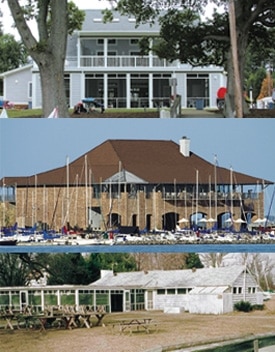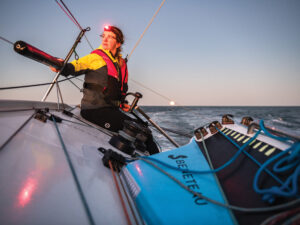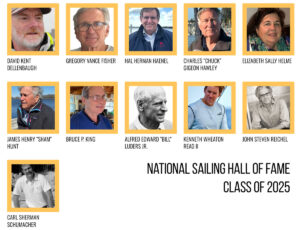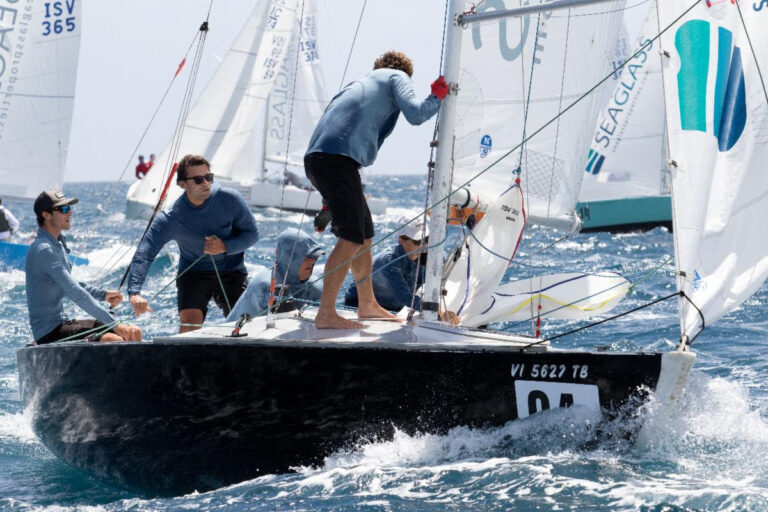
Jobson Collage
One of the most encouraging trends I found during a 30-city lecture tour last spring is how many yacht clubs have constructed new buildings or renovated existing property. Yacht clubs are the backbone of organized sailing, and it’s a minor miracle that so many waterfront facilities exist in the United States. Happily, as clubs improve their precious real estate and develop popular programs on and off the water, membership rosters are expanding. There are lessons to be learned from these yacht clubs’ successes at taking on big construction projects. Funding might seem like the biggest obstacle. But in every interview I learned that a careful definition of what’s needed, leading to a concise vision, was most important to selling a concept to a club’s membership. Here’s a sample of what several clubs did. The Tred Avon YC, in Oxford, Md., met initial resistance to a new building. Members felt comfortable with their old building. Commodore Harry Dundore was one of several leaders who worked on a plan to build interest. Member Totch Hartge described the process as “beautifully administered. Every member gave input into the project. The design was tweaked until everyone was happy.” Apparently there was considerable concern at Tred Avon that members would resign, but in the end only 10 left. Every member was asked to contribute $3,000. According to Hartge, 75 percent paid in cash and 25 percent spread the payment out over a few years. The Tiburon YC, in Tiburon, Calif., first discussed a new building way back in 1973. In 1998 the project finally got serious. Contractors were hired for driving piles, sheet rocking, and framing, but most of the other work was completed by members themselves. Member Dr. Allen Dekelboum told me the project took two years and cost $500,000. “It was an easy sell,” he said. “Funding was generated from member’s loans. The loans are being paid back over a 10-year period.” Dekelboum is enthusiastic about the result, saying, “Our membership increased. Everyone has a lot of pride in the club because we all participated.” The club is now working on a new project to dredge their harbor. Like many members, Commodore Julie Muller of the Jackson YC in Mississippi was shocked when their old 3,000-square-foot clubhouse burned down, taking with it the club’s valuable trophies. Still, the economy in the area is booming, and there was no question that Jackson was ready to rebuild, and make the new clubhouse larger. But the project was not easy. According to Muller, “We set up a committee to survey the membership to find out what they wanted. It was clear most members wanted expanded services. We next did a cost analysis and decided on a new 11,000-square-foot building. This was a big step for us.” The process went slowly at first. The survey results were used to develop a final design but the membership rejected it. Muller says, “We needed help. We used Professor Sam Mockbee of Auburn University to contribute to the project, and he did a beautiful design. We were very lucky to have him. Sadly he died during the construction.” Jackson YC now hosts many big regattas, has hired a full-time sailing coach, and encourages visitors to sail in their events by providing camping grounds. When the club burned there were 250 members, but today, thanks to the new building, there are 400. The commodore is proud that the regatta schedule never slowed down during construction. “Our club is always about sailing and will also be for our sailors. We are now looking to increase the size of our harbor for our out of town guests.” The Fishing Bay YC, in Deltaville, Va., was an old cinderblock-and-frame building. It had a small porch and was perfect for potluck suppers, but the time had come to renovate. Commodore Judy Buis got the project started in 1999 after recommendations by the long range planning committee. Current Commodore Dick Cole credits Strother Scott and Jerry Dennison among others for helping secure financing for the project. “We did not want to assess the members, so we asked for donations,” he says. “It was clear people cared-we took in $450,000 in donations. We also received considerable gifts-in-kind like furniture.” Many of the donations came in over a three-year period and 60 percent of the membership made contributions. The new, two-story building is 7,000 square feet, and according to Cole, membership has increased to the point where there is now a waiting list. There’s a new effort now to focus on junior activities, plus another project on the horizon-a new dock. The Port Huron YC sits in a quiet part of the world most of the year. But during the days leading up to the Mackinac Race, the city comes alive with hundreds of boats and thousands of sailors. The old building simply wasn’t suitable for such crowds, so the club built a new two-story building with an impressive marina next door. Commodore Terry Vigrass says volunteer labor from members kept the project to one third of the commercial cost. “We charge reduced slip fees to our members,”he says, “which keeps them volunteering.” The club acquired the land from the U.S. Coast Guard and went through a lengthy permit process to get permission to dig out the land. At my club, the Annapolis YC, a series of renovations to the primary building have been successfully completed over the past 10 years. What was needed was space for growing one-design activity, which was found by acquiring a boatyard across the river (“Lessons in Starting a New Fleet,” March ’03). Overseen by Jack Lynch, the project of turning a working yard into a one-design facility took a long time, but, says Lynch, “We had no resistance from the club. Everyone was behind it.” The $350,000 construction project, recently completed, includes three hoists. In addition to these clubs, I’ve heard of dozens of others working to update their facilities. The consensus is that a long range planning committee is the place to set the stage. Good salesmanship is vital to getting members on board, but it’s easier to sell them on an ambitious project if a thoughtful study has been conducted. Clubs also report that it’s important to be flexible, because new ideas will emerge through the design process. These are tough, expensive, and time-consuming projects, but the results ensure that the yacht club remains an essential sailing and social center for many years in the future.









